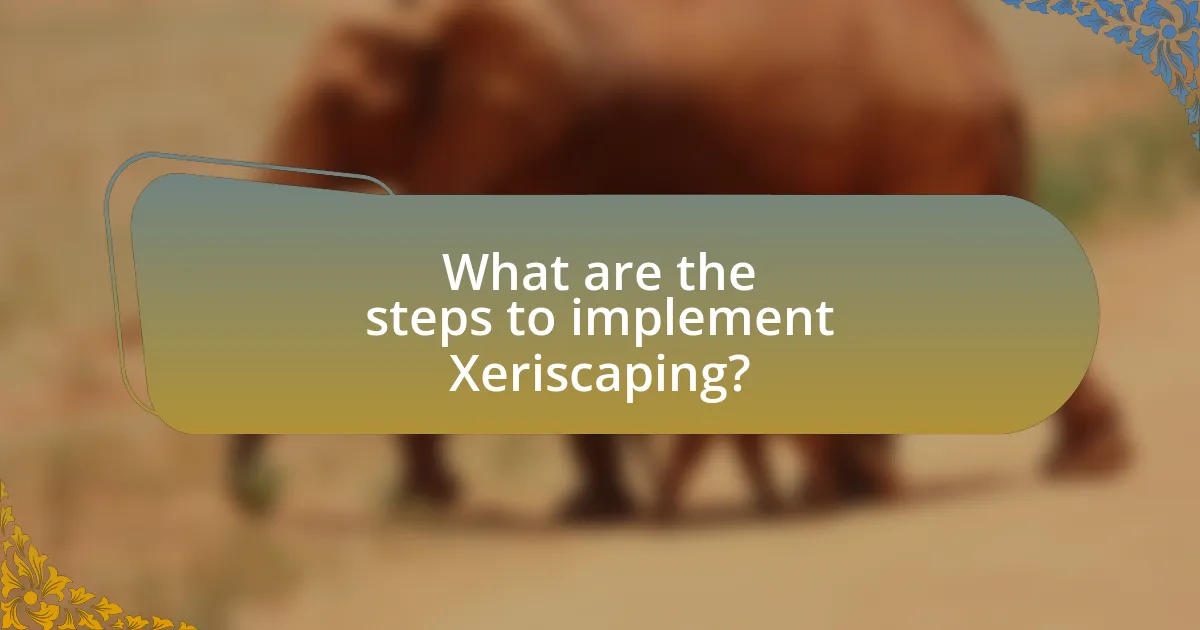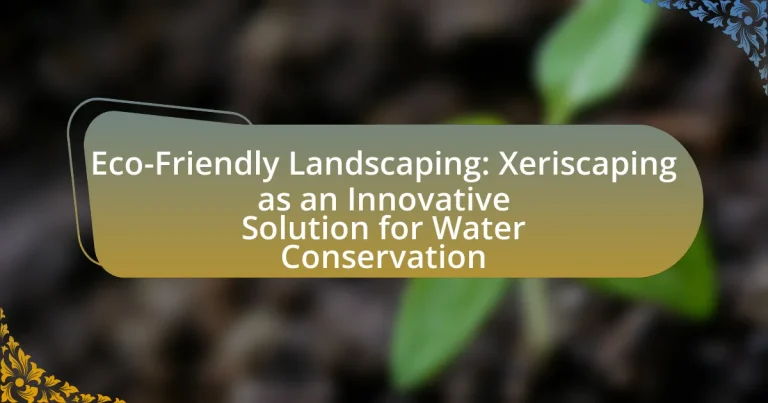Eco-friendly landscaping, particularly through xeriscaping, emphasizes sustainable gardening practices that prioritize water conservation and the use of native plants. Xeriscaping significantly reduces water usage—by up to 50%—compared to traditional landscaping methods by incorporating drought-resistant plants and efficient irrigation techniques. The article outlines the principles of xeriscaping, its benefits for biodiversity and ecosystem health, and the economic advantages it offers, such as lower maintenance costs. Additionally, it addresses the steps for implementing xeriscaping, common challenges faced, and best practices for maintaining a xeriscape garden, highlighting its role as an innovative solution for water conservation in landscaping.

What is Eco-Friendly Landscaping and Xeriscaping?
Eco-friendly landscaping refers to gardening practices that prioritize environmental sustainability, focusing on native plants, organic gardening methods, and resource conservation. Xeriscaping is a specific type of eco-friendly landscaping that emphasizes water conservation by using drought-resistant plants and efficient irrigation techniques. This approach can reduce water usage by up to 50% compared to traditional landscaping methods, making it an effective solution for areas prone to drought.
How does Xeriscaping contribute to water conservation?
Xeriscaping contributes to water conservation by utilizing drought-resistant plants and efficient landscaping techniques that minimize water usage. This method reduces the need for irrigation by selecting native and adapted plants that thrive in local climates, thereby significantly lowering water consumption. Research indicates that xeriscaping can reduce landscape water use by up to 50% compared to traditional landscaping methods, as reported by the American Society of Landscape Architects. By implementing practices such as mulching, soil amendment, and efficient irrigation systems, xeriscaping effectively conserves water resources while maintaining aesthetic appeal.
What are the key principles of Xeriscaping?
The key principles of Xeriscaping include planning and design, soil improvement, efficient irrigation, plant selection, mulching, and maintenance. Planning and design involve creating a landscape that minimizes water use while maximizing aesthetic appeal. Soil improvement enhances water retention and drainage, making it more conducive to plant growth. Efficient irrigation techniques, such as drip systems, reduce water waste. Plant selection focuses on drought-resistant species that thrive in local climates, thereby reducing the need for supplemental watering. Mulching conserves moisture and suppresses weeds, while regular maintenance ensures the landscape remains healthy and efficient. These principles collectively contribute to effective water conservation in landscaping.
How does Xeriscaping differ from traditional landscaping?
Xeriscaping differs from traditional landscaping primarily in its focus on water conservation. While traditional landscaping often relies on extensive irrigation and water usage to maintain lush, green lawns and gardens, xeriscaping emphasizes the use of drought-resistant plants and efficient irrigation techniques to minimize water consumption. Xeriscaping incorporates native plants that are adapted to local climate conditions, reducing the need for supplemental watering. According to the American Society of Landscape Architects, xeriscaping can reduce outdoor water use by up to 50% compared to conventional landscaping methods.
Why is water conservation important in landscaping?
Water conservation is important in landscaping because it reduces water waste and promotes sustainable practices. Efficient water use in landscaping helps maintain healthy ecosystems, supports plant growth, and minimizes the environmental impact of irrigation. According to the U.S. Environmental Protection Agency, outdoor water use accounts for nearly 30% of total household water use, with much of it wasted through inefficient practices. Implementing water conservation techniques, such as xeriscaping, can significantly lower water consumption while still achieving aesthetically pleasing landscapes.
What are the environmental impacts of water overuse?
Water overuse leads to significant environmental impacts, including the depletion of freshwater resources, habitat destruction, and increased salinity in soil and water bodies. The excessive extraction of water from rivers and aquifers reduces water availability for ecosystems, threatening biodiversity and disrupting natural habitats. For instance, studies indicate that over-extraction can lower water tables, leading to the loss of wetlands, which are crucial for wildlife and water filtration. Additionally, when freshwater is overused, it can result in higher concentrations of salts in the remaining water, adversely affecting plant growth and soil health. These impacts highlight the urgent need for sustainable water management practices, such as xeriscaping, to conserve water and protect the environment.
How does Xeriscaping help mitigate drought conditions?
Xeriscaping helps mitigate drought conditions by utilizing drought-resistant plants and efficient landscaping techniques that reduce water consumption. This approach minimizes the need for irrigation by selecting native or adapted plants that thrive in local climates, thereby conserving water resources. Studies indicate that xeriscaped landscapes can reduce water usage by up to 50% compared to traditional landscaping methods, making it a sustainable solution for areas facing water scarcity.

What are the benefits of Xeriscaping?
Xeriscaping offers multiple benefits, primarily focused on water conservation and sustainability. This landscaping method significantly reduces water usage by utilizing drought-resistant plants and efficient irrigation techniques, which can decrease water consumption by up to 50% compared to traditional landscaping. Additionally, xeriscaping minimizes maintenance costs and labor, as native plants typically require less care and are more resilient to local climate conditions. Furthermore, xeriscaping enhances biodiversity by providing habitats for local wildlife, contributing to healthier ecosystems. These advantages make xeriscaping an effective solution for environmentally conscious landscaping.
How does Xeriscaping enhance biodiversity?
Xeriscaping enhances biodiversity by creating habitats that support a variety of native plants and wildlife. This landscaping method emphasizes the use of drought-resistant plants that are well-adapted to local ecosystems, which in turn attracts diverse species such as pollinators, birds, and beneficial insects. Research indicates that areas designed with xeriscaping principles can increase local biodiversity by providing food and shelter for these organisms, thereby fostering a balanced ecosystem. For example, a study published in the Journal of Environmental Management found that gardens incorporating native xeriscape plants had 50% more insect species compared to traditional lawns, demonstrating the positive impact of xeriscaping on ecological diversity.
What types of plants are commonly used in Xeriscaping?
Commonly used plants in Xeriscaping include succulents, native grasses, and drought-tolerant perennials. Succulents like agave and aloe vera store water in their leaves, making them ideal for arid environments. Native grasses such as blue grama and buffalo grass require minimal irrigation and adapt well to local climates. Drought-tolerant perennials like lavender and salvia thrive with little water and provide color and habitat for wildlife. These plant types are specifically chosen for their ability to survive with limited water, aligning with the principles of Xeriscaping aimed at water conservation.
How do native plants contribute to ecosystem health?
Native plants contribute to ecosystem health by enhancing biodiversity, improving soil quality, and supporting local wildlife. These plants are adapted to their specific environments, which allows them to thrive with minimal resources, thereby reducing the need for chemical fertilizers and pesticides. Research indicates that native plants can increase the abundance and diversity of pollinators, such as bees and butterflies, which are crucial for the reproduction of many flowering plants. Additionally, native vegetation helps prevent soil erosion and promotes water retention, leading to healthier soil ecosystems. Studies show that areas with native plant communities can support up to 50% more wildlife than those dominated by non-native species, underscoring their vital role in maintaining ecological balance.
What economic advantages does Xeriscaping offer?
Xeriscaping offers significant economic advantages, primarily through reduced water costs and lower maintenance expenses. By utilizing drought-resistant plants and efficient irrigation techniques, xeriscaping minimizes water usage, leading to substantial savings on water bills. For instance, studies indicate that xeriscaped landscapes can reduce water consumption by up to 50% compared to traditional landscaping. Additionally, the lower maintenance requirements of xeriscaped gardens, which often involve less frequent mowing, fertilizing, and pest control, result in decreased labor and material costs. This combination of reduced water and maintenance expenses makes xeriscaping a financially beneficial choice for homeowners and municipalities alike.
How can Xeriscaping reduce landscaping maintenance costs?
Xeriscaping can significantly reduce landscaping maintenance costs by minimizing water usage and the need for extensive upkeep. This landscaping method utilizes drought-resistant plants and efficient irrigation techniques, which lowers water bills and reduces the frequency of watering. According to the American Society of Landscape Architects, xeriscaping can cut water consumption by up to 50%, leading to decreased labor costs associated with watering and plant care. Additionally, the use of native plants that require less fertilization and pest control further decreases maintenance expenses, as these plants are adapted to local conditions and are more resilient.
What are the long-term savings associated with Xeriscaping?
Xeriscaping can lead to significant long-term savings in water and maintenance costs. By utilizing drought-resistant plants and efficient irrigation techniques, homeowners can reduce their water usage by up to 50% compared to traditional landscaping. This reduction in water consumption translates to lower utility bills over time. Additionally, xeriscaped gardens typically require less maintenance, which can save homeowners on landscaping services and labor costs. Studies have shown that initial investments in xeriscaping can be recouped within a few years through these ongoing savings, making it a financially viable option for sustainable landscaping.

What are the steps to implement Xeriscaping?
To implement Xeriscaping, follow these steps: assess your landscape, plan your design, improve soil quality, select drought-resistant plants, group plants by water needs, install efficient irrigation systems, and maintain the landscape.
Assessing the landscape involves evaluating the existing conditions, including sunlight, soil type, and drainage. Planning the design requires creating a layout that incorporates native and drought-tolerant plants, ensuring aesthetic appeal while minimizing water use. Improving soil quality can be achieved by adding organic matter to enhance water retention. Selecting drought-resistant plants is crucial, as they require less water and are better suited for arid conditions. Grouping plants by their water needs optimizes irrigation efficiency. Installing efficient irrigation systems, such as drip irrigation, reduces water waste. Finally, maintaining the landscape includes regular monitoring and adjusting care practices to ensure plant health and water conservation.
These steps are supported by studies indicating that Xeriscaping can reduce landscape water use by up to 50% compared to traditional landscaping methods.
How do you assess your landscape for Xeriscaping potential?
To assess your landscape for Xeriscaping potential, evaluate the existing soil type, sunlight exposure, and water drainage. Soil analysis reveals its texture and nutrient content, which influences plant selection; for instance, sandy soils drain quickly, while clay retains moisture. Sunlight exposure determines which areas are suitable for drought-tolerant plants, as some require full sun while others thrive in partial shade. Additionally, assessing water drainage helps identify areas prone to pooling, which may require specific plant choices or modifications to improve drainage. These factors collectively inform the design and implementation of a Xeriscape, promoting efficient water use and sustainable landscaping practices.
What factors should be considered in soil preparation?
Soil preparation for xeriscaping requires consideration of soil type, drainage, pH levels, organic matter content, and compaction. Soil type influences water retention and nutrient availability; for instance, sandy soils drain quickly but may require amendments to retain moisture. Proper drainage is essential to prevent waterlogging, which can harm plant roots. pH levels affect nutrient availability, with most plants thriving in a pH range of 6.0 to 7.5. Incorporating organic matter enhances soil structure, improves moisture retention, and provides nutrients. Lastly, addressing soil compaction is crucial, as compacted soil restricts root growth and water infiltration. These factors collectively ensure a healthy environment for xeriscaping, promoting water conservation and plant sustainability.
How can you design a Xeriscape layout effectively?
To design a Xeriscape layout effectively, start by assessing the site conditions, including soil type, sun exposure, and drainage patterns. This foundational step allows for the selection of appropriate drought-tolerant plants that thrive in the specific environment. Incorporating native plants is crucial, as they are adapted to local climate conditions and require less water once established.
Additionally, grouping plants with similar water needs together minimizes water usage and promotes efficient irrigation practices. Implementing hardscaping elements, such as gravel paths and stone features, reduces the area needing irrigation and enhances aesthetic appeal.
Finally, using mulch around plants conserves moisture, suppresses weeds, and improves soil health. Research indicates that Xeriscaping can reduce landscape water use by up to 60%, demonstrating its effectiveness in water conservation.
What are common challenges in Xeriscaping?
Common challenges in Xeriscaping include soil quality issues, plant selection difficulties, and initial installation costs. Soil quality can be poor in arid regions, requiring amendments to support drought-tolerant plants. Selecting appropriate native or drought-resistant plants can be challenging due to limited availability or lack of knowledge about local species. Additionally, while Xeriscaping can reduce water usage over time, the upfront costs for landscaping design and installation can be higher compared to traditional landscaping methods. These challenges can hinder the successful implementation of Xeriscaping practices.
How can you address pest management in Xeriscaping?
To address pest management in Xeriscaping, implement integrated pest management (IPM) strategies that focus on prevention, monitoring, and control. This approach emphasizes the use of native plants that are more resistant to local pests, reducing the need for chemical interventions. Research indicates that native plants support local ecosystems and attract beneficial insects, which can naturally control pest populations. For example, a study published in the Journal of Environmental Horticulture found that gardens with native plants had significantly lower pest levels compared to those with non-native species. Additionally, regular monitoring for pest activity and the use of organic pest control methods, such as insecticidal soaps or neem oil, can effectively manage outbreaks while maintaining the ecological balance essential in Xeriscaping.
What strategies can help with plant selection and placement?
Effective strategies for plant selection and placement in xeriscaping include assessing local climate conditions, understanding soil types, and selecting native or drought-tolerant plants. By evaluating the specific climate, such as temperature ranges and rainfall patterns, landscapers can choose plants that thrive in those conditions, reducing water usage. Additionally, analyzing soil types helps in determining which plants will establish well and require minimal irrigation. Research indicates that native plants are adapted to local environments and often require less maintenance and water, making them ideal for xeriscaping. For instance, a study by the University of Arizona highlights that using native plants can reduce landscape water use by up to 50%. Proper placement involves grouping plants with similar water needs together and considering sun and shade patterns to optimize growth and minimize water consumption.
What are best practices for maintaining a Xeriscape garden?
Best practices for maintaining a Xeriscape garden include selecting drought-resistant plants, grouping plants with similar water needs, and using mulch to retain moisture. Drought-resistant plants, such as succulents and native species, require less water and thrive in arid conditions. Grouping plants with similar water requirements minimizes water waste and ensures efficient irrigation. Applying mulch around plants helps reduce evaporation, suppress weeds, and maintain soil temperature. Regularly monitoring soil moisture and adjusting irrigation schedules based on seasonal changes further enhances water conservation efforts in a Xeriscape garden.
How often should you water a Xeriscape garden?
A Xeriscape garden should be watered infrequently, typically once every two to four weeks, depending on the climate and specific plant needs. This approach conserves water by utilizing drought-resistant plants that require minimal irrigation. Research indicates that Xeriscaping can reduce water usage by up to 50% compared to traditional landscaping methods, making it an effective strategy for water conservation.
What tools are essential for maintaining a Xeriscape landscape?
Essential tools for maintaining a Xeriscape landscape include a hand trowel, pruners, a rake, a hoe, and a drip irrigation system. These tools facilitate efficient planting, pruning, soil management, and water conservation, which are critical for the success of a Xeriscape. For instance, a drip irrigation system delivers water directly to the roots of plants, minimizing evaporation and runoff, thus aligning with the principles of Xeriscaping that emphasize water efficiency.


